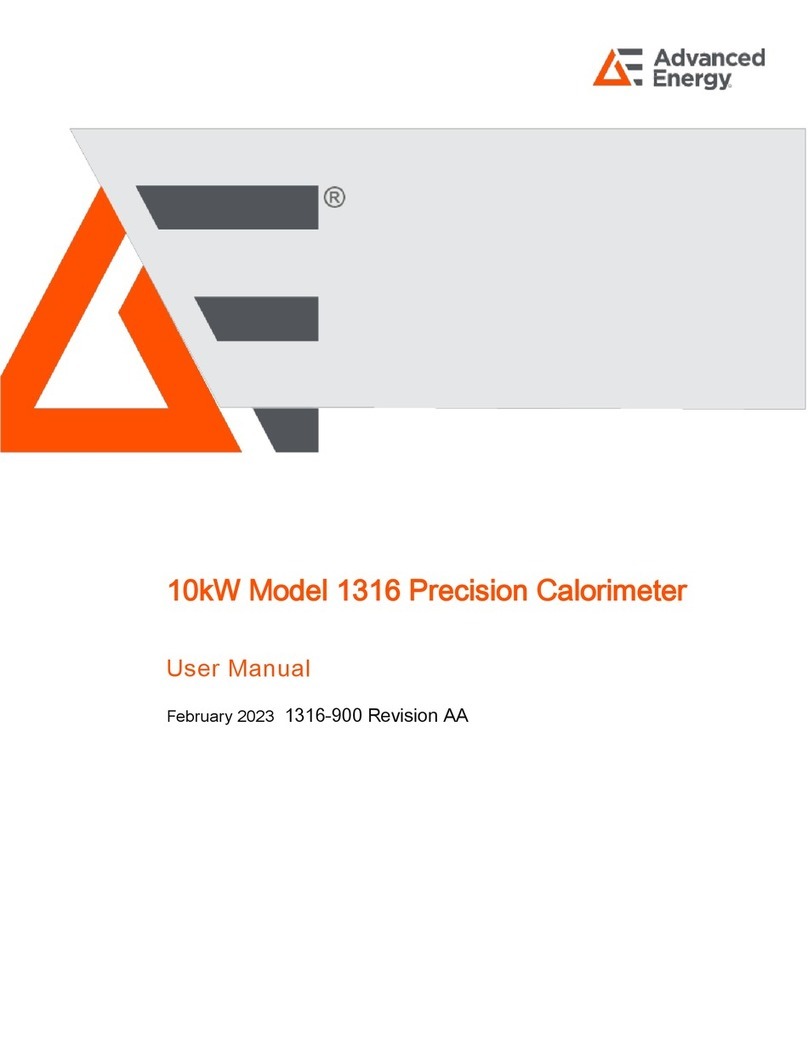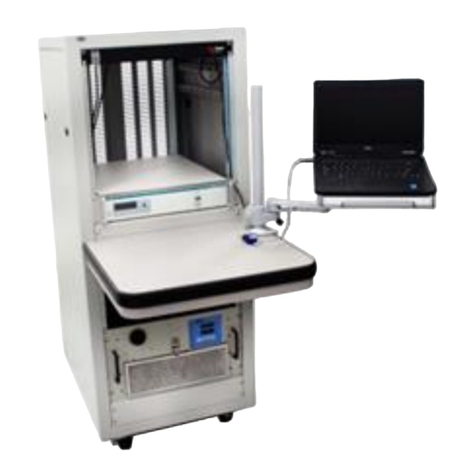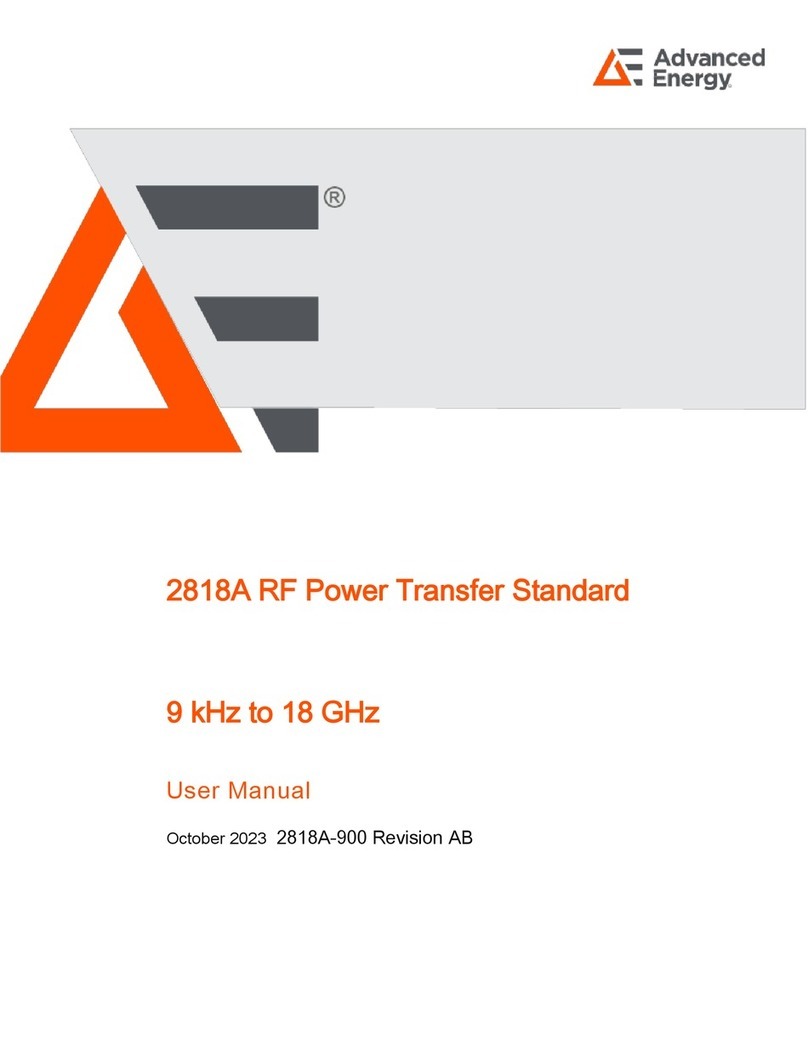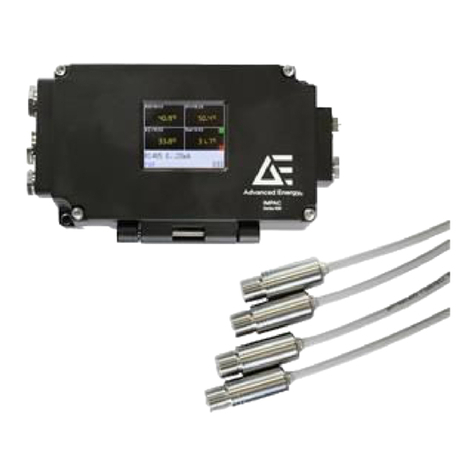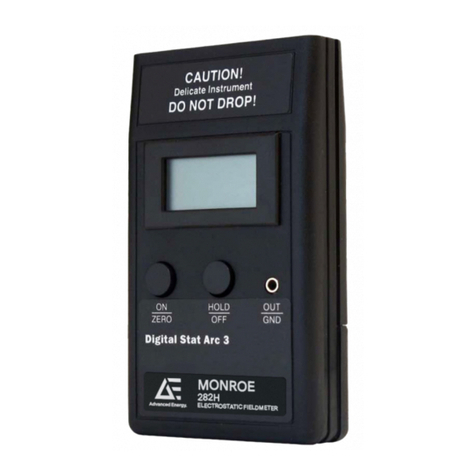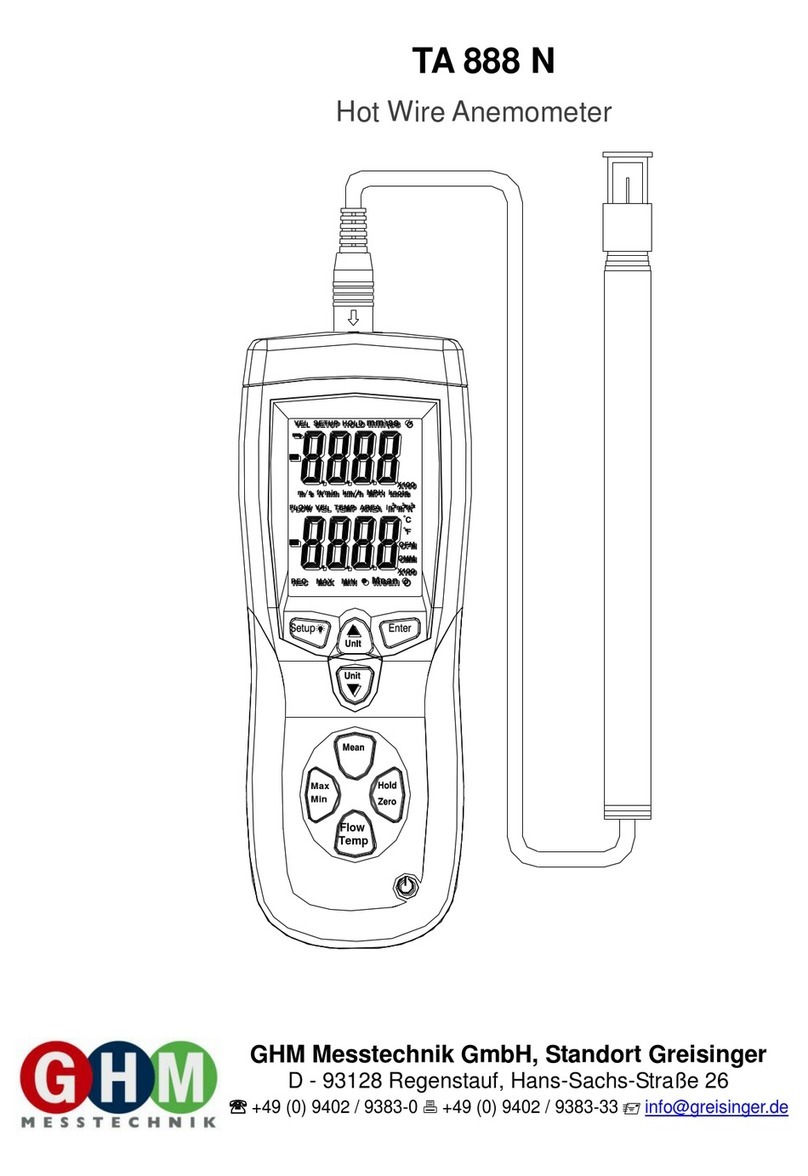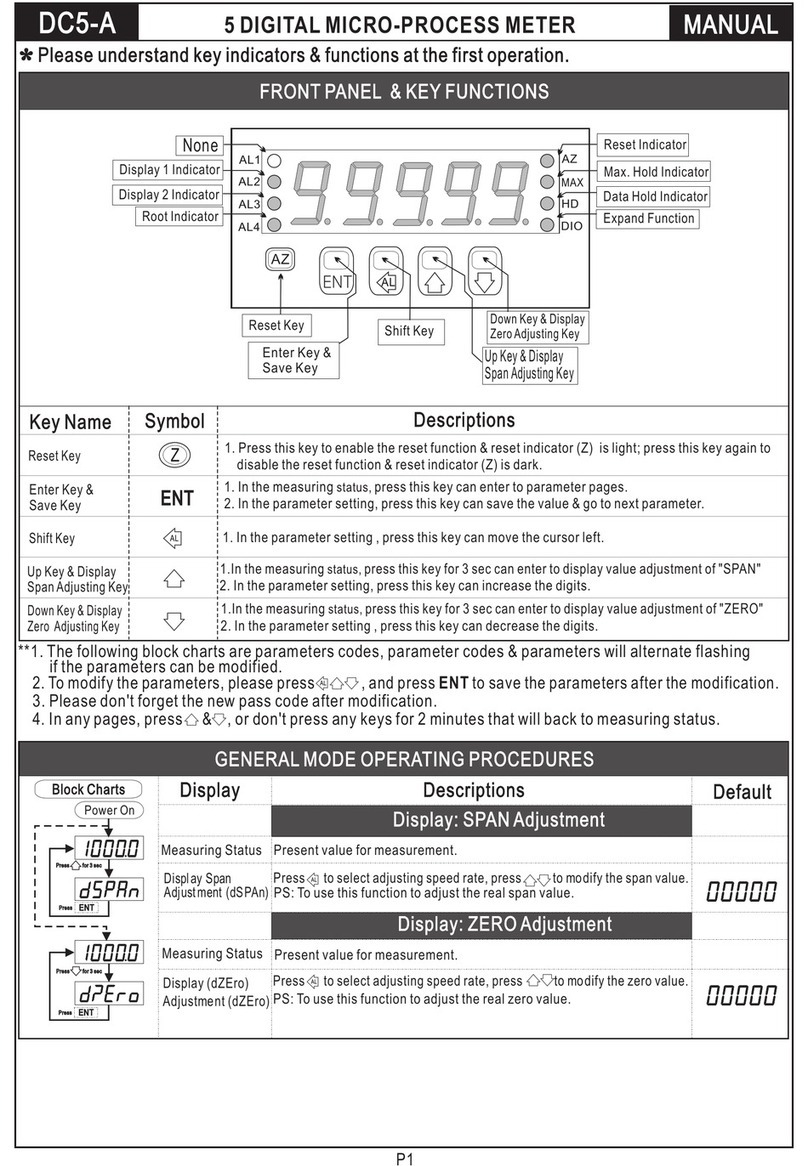Advanced Energy LumaSense Technologies E2T QUASAR Series User manual

OPERATION MANUAL
E2T QUASAR Flare Monitors
M8100PM-EXP • M8100FM-EXP • M8100SM-EXP

E2T QUASAR Flare Monitors Operation Manual General •ii
Confidential Information
The material contained herein consists of information that is the property of LumaSense
Technologies, an Advanced Energy Company, and intended solely for use by the purchaser of
the equipment described in this manual.
All specifications are subject to change without notice. Changes are made periodically to the
information in this publication, and these changes will be incorporated in new editions.
LumaSense Technologies prohibits the duplication of any portion of this manual or the use
thereof for any purpose other than the operation or maintenance of the equipment described
in this manual, without the express written permission of LumaSense Technologies or Advanced
Energy Industries, Inc.
Any unauthorized use of this manual or its contents is strictly prohibited.
Copyright
© 2018 LumaSense Technologies, Inc. All Rights Reserved. LumaSense Technologies, Inc., a
subsidiary of Advanced Energy Industries, Inc.
Trademarks
E2T is a trademark of LumaSense Technologies.
All other trademarks are trademarks, registered trademarks, and/or service marks of their
respective holders.
Service Centers
LumaSense Technologies, Inc.
North America
Sales & Service
Santa Clara, CA, 95054
Ph: +1 800 631 0176
Ph: +1 408 727 1600
Fax: +1 408 727 1677
LumaSense Sensor GmbH
Other Than North America
Sales & Support
Frankfurt, Germany
Ph: +49 (0) 69 97373 0
Fax: +49 (0) 69 97373 167
Global and Regional Centers
Our Headquarters
LumaSense Technologies, Inc.
Santa Clara, CA, USA
Ph: +1 800 631 0176
Fax: +1 408 727 1677
Americas, Australia, & Other Asia
LumaSense Technologies, Inc.
Santa Clara, CA, USA
Ph: +1 800 631 0176
Fax: +1 408 727 1677
Europe, Middle East, Africa
LumaSense Technologies GmbH
Frankfurt, Germany
Ph: +49 (0) 69 97373 0
Fax: +49 (0) 69 97373 167
France
LumaSense Technologies Sarl
Erstein, France
Ph: +33 3 8898 9801
Fax: +33 3 8898 9732
India
LumaSense Technologies, India
Mumbai, India
Ph: + 91 22 67419203
Fax: + 91 22 67419201
China
LumaSense Technologies, China
Shanghai, China
Ph: +86 133 1182 7766
Ph: +86 21 5899 7915
E-mail
Website
http://www.lumasenseinc.com
Part No 11180-75-EN
Rev. G
February 2019

E2T QUASAR Flare Monitors Operation Manual General •iii
Contents
1General............................................................................................................................. 7
1.1 Information about the user manual...................................................................... 7
1.1.1 Legend......................................................................................................................7
1.2 Safety ....................................................................................................................... 7
1.2.1 Explosion Proof Housing .........................................................................................8
1.3 Limit of Liability and Warranty.............................................................................. 8
1.4 Unpacking and Inspection ...................................................................................... 8
1.5 Service Request, Repair, or Support...................................................................... 9
1.6 Shipments to LumaSense for Repair ................................................................... 10
1.7 Disposal / Decommissioning ................................................................................ 10
2Introduction................................................................................................................... 11
2.1 System Overview .................................................................................................. 11
2.2 System Features .................................................................................................... 12
2.3 Principle of Operation .......................................................................................... 13
2.3.1 Alarm Set Point ......................................................................................................13
2.3.2 Relay Contacts........................................................................................................13
2.4 Signal Path............................................................................................................. 13
2.4.1 SM: Smoke Monitor’s Dual Wavelength (2 color) ...............................................13
2.4.2 PM: Pilot Monitor’s Flame Sensitive Wavelength................................................14
2.4.3 FM: Flare Monitor’s Flame Sensitive Wavelength ...............................................14
2.5 Quick Installation Procedure................................................................................ 14
3Mechanical Installation................................................................................................. 17
3.1 Getting Started ..................................................................................................... 17
3.2 Sight Assessment .................................................................................................. 17
3.2.1 Pilot Monitor (PM) Sighting..................................................................................17
3.2.2 Flare Monitor (FM) Sighting..................................................................................18
3.2.3 Smoke Monitor (SM) Sighting...............................................................................18
3.2.4 Mounting Options .................................................................................................18
3.3 Ambient Temperature Limits ............................................................................... 19
3.4 Cooling Requirements .......................................................................................... 19
3.4.1 Water Cooling........................................................................................................19
3.4.2 Vortex Air Cooling .................................................................................................20
3.5 Viewport Air Purge Requirements....................................................................... 20
3.6 Target Size and Focusing Range .......................................................................... 20
3.7 Focusing on the Target (Adjust Lens).................................................................. 20
4Electrical Installation .................................................................................................... 23
4.1 Electrical Installation Guidelines ......................................................................... 23
4.1.1 Conduit/Connections .............................................................................................23
4.1.2 Over-Current Protection/Service Switch ...............................................................23

E2T QUASAR Flare Monitors Operation Manual General •iv
4.2 Power Connections ............................................................................................... 23
4.2.1 Service Markings ....................................................................................................23
4.2.2 Protective Ground Connection .............................................................................24
4.2.3 Cover Attachment..................................................................................................24
4.2.4 Powering with 115 Volts AC∽...............................................................................25
4.2.5 Powering with 220/230 Volts AC∽........................................................................25
4.2.6 Powering with 24 Volts DC ..........................................................................25
4.3 Fusing..................................................................................................................... 26
4.3.1 Mains ......................................................................................................................26
4.3.2 Heater.....................................................................................................................26
4.4 Connection for mA Output................................................................................... 26
4.5 Connecting the Set Point Relay ........................................................................... 27
5Operating the M8100PM-EXP ....................................................................................... 29
5.1 Start-Up Operation Checklist, Pilot Monitor (PM) .............................................. 31
5.1.1 Getting Started ......................................................................................................31
5.1.2 Initial Control Settings...........................................................................................32
5.1.3 Delay Setting..........................................................................................................32
5.1.4 System Gain/Climate Compensation.....................................................................32
5.1.5 Oscillation on the Analog Meter ..........................................................................32
5.1.6 Noise Amplification ...............................................................................................33
5.1.7 Relay Contacts........................................................................................................33
5.1.8 Delay Adjust ...........................................................................................................34
5.1.9 Milliamp Output (+mA / -mA)...............................................................................34
6Operating the M8100FM-EXP........................................................................................ 35
6.1 Start-Up Operation Checklist, Flare Monitor (FM).............................................. 36
6.1.1 Getting Started ......................................................................................................36
6.1.2 Initial Control Settings...........................................................................................37
6.1.3 Delay Setting..........................................................................................................37
6.1.4 System Gain/Climate Compensation.....................................................................37
6.1.5 Oscillation on the Analog Meter ..........................................................................37
6.1.6 Flare Monitor (FM).................................................................................................37
6.1.7 Noise Amplification ...............................................................................................38
6.1.8 Relay Contacts........................................................................................................39
6.1.9 Delay Adjust ...........................................................................................................39
6.1.10 Milliamp Output (+mA / -mA)...............................................................................39
6.2 Considerations for the Flare Monitor (FM)......................................................... 39
7Operating the M8100SM-EXP ....................................................................................... 41
7.1 Start-Up Operation Checklist, Smoke Monitor (SM) .......................................... 43
7.1.1 Getting Started ......................................................................................................43
7.1.2 Initial Control Settings...........................................................................................44
7.1.3 System Gain/Climate Compensation.....................................................................44
7.1.4 Set-point.................................................................................................................44
7.1.5 Relay Contacts........................................................................................................44
7.1.6 Delay Adjust ...........................................................................................................45
7.1.7 Milliamp Output (+mA / -mA)...............................................................................45
7.1.8 Final Steps...............................................................................................................45
7.2 Considerations for the Smoke Monitor .............................................................. 45

E2T QUASAR Flare Monitors Operation Manual General •v
8Troubleshooting ............................................................................................................ 47
8.1 Problem Isolation Checkout Procedure............................................................... 47
8.1.1 Sight Path and Optical Alignment........................................................................47
8.1.2 Power Input............................................................................................................47
8.1.3 Power Fuse .............................................................................................................47
8.1.4 Instrument Loops ...................................................................................................47
8.1.5 Stopped Chopper Wheel.......................................................................................48
8.1.6 Broken Wire Harness .............................................................................................48
8.1.7 Component Failure ................................................................................................49
9Maintenance .................................................................................................................. 51
9.1 General Maintenance............................................................................................ 51
9.1.1 Chopper Motor Repair ..........................................................................................51
9.2 Cleaning the Optics............................................................................................... 52
10 Safety Assurances and Precautions ............................................................................. 53
10.1 Hazardous Environment Safety ........................................................................... 53
10.2 Electrical Service Protection................................................................................. 53
10.2.1 Over-Current Protection / Service Switch .............................................................53
10.2.2 Over-Voltage Protection .......................................................................................53
10.2.3 Transient Protection ..............................................................................................54
10.2.4 Wiring.....................................................................................................................54
10.2.5 Protective Ground Connection .............................................................................54
Appendix A: Specifications and Parameter Settings........................................................ 55
Appendix B: Area Classification/Protection Concepts...................................................... 57
Label Markings .............................................................................................................. 57
Protection Concepts, Article 500.................................................................................. 58
Appendix C: Declaration of Conformity/ Certificate ........................................................ 61
Appendix D: Statement of Limited Warranty, New Instruments.................................... 63
Appendix E: Engineering Drawings ................................................................................... 65
Index..................................................................................................................................... 71

E2T QUASAR Flare Monitors Operation Manual General •vi
To ensure consistent document formatting, this page was intentionally left blank.

E2T QUASAR Flare Monitors Operation Manual General •7
1General
1.1 Information about the user manual
This manual provides important information that can be used as a work of reference for
installing, operating, maintaining, aligning, and/or troubleshooting your LumaSense
Instrument. It is important that you carefully read the information contained in this manual and
follow all safety procedures before you install or operate the system. To avoid handling errors,
keep this manual in a location where it will be readily accessible.
1.1.1 Legend
Note: Indicates tips and useful information in this manual. All notes should be read
to effectively operate the instrument.
Caution: Denotes information critical to avoiding instrument damage or a severe
impact to processing. When this symbol is found on the instrument it
indicates a potential hazard. Consult the documentation before
proceeding with any actions.
Warning: Denotes information critical to avoiding personal injury, such as when an
electrical hazard is present. When this symbol is found on the instrument it
indicates a potential hazard. Consult the documentation before
proceeding with any actions).
Protective Earth Ground connection.
Caution Must be Followed: reference supplied documents.
Electric Shock Hazard: disconnect service before opening.
∽
Voltage Alternating current (VAC).
Voltage Direct Current (VDC).
1.2 Safety
This manual provides important information on safely installing and operating your LumaSense
Instrument. Several sections of this manual provide safety warnings to avert danger. These
safety warnings are specified with a warning symbol. You must read and understand the
contents of this manual before operating the instrument even if you have used similar
instruments or have already been trained by the manufacturer.
It is also important to continually pay attention to all labels and markings on the instrument and
to keep the labels and markings in a permanent readable condition.
See Chapter 10 Safety Assurances and Precautions,for more information.

E2T QUASAR Flare Monitors Operation Manual General •8
1.2.1 Explosion Proof Housing
The housing is designed to meet the explosion-proof requirements of the National Fire
Protection Association (NFPA) Article 500 for hazardous locations. This Instrument holds both
CSA International and European (ATEX) certifications.
To ensure safe operating conditions, it is recommended that you review the certification and
area classifications that pertain to this system:
Reference
•Appendix B, Area Classification/Protection Concepts
•Appendix C, Declaration of Conformity/Certificate
Warning: Service personnel shall be qualified to install and service electrical
equipment designed for areas classified as hazardous. At no time should the cover be
removed unless power is switched off first. When it is necessary to service the
instrument with the power applied, ensure proper safe environmental conditions exist
and that such maintenance is authorized and pursuant to safe conditions. See
Chapter 10, Safety Assurances and Precautions, for more information.
1.3 Limit of Liability and Warranty
All general information and notes for handling, maintenance and cleaning of this instrument
are offered according to the best of our knowledge and experience.
LumaSense Technologies is not liable for any damages that arise from the use of any examples
or processes mentioned in this manual or in case the content of this document should be
incomplete or incorrect. LumaSense Technologies reserves the right to revise this document and
to make changes from time to time in the content hereof without obligation to notify any
person or persons of such revisions or changes.
All instruments from LumaSense Technologies have a regionally effective warranty period. This
warranty covers manufacturing defects and faults which arise during operation, only if they are
the result of defects caused by LumaSense Technologies.
See Appendix D: Statement of Limited Warranty, New Instruments, for more
information.
1.4 Unpacking and Inspection
Before unpacking the instrument, locate the packing invoice on the outside of the carton. The
invoice lists every item that was included in your shipment. Each LumaSense E2T QUASAR
M8100-EXP instrument is configured to customer specifications. It is recommended that you
confirm that the instrument’s configuration meets expectation by carefully reviewing the
packing slip details.

E2T QUASAR Flare Monitors Operation Manual General •9
When unpacking and inspecting your system, you need to do the following:
•Check all materials in the container against the enclosed packing list.
•LumaSense Technologies cannot be responsible for shortages against the packing
list unless a claim is immediately filed with the carrier. Final claim and negotiations
with the carrier must be completed by the customer.
•Carefully unpack and inspect all components for visible damage.
•Save all packing materials, including the carrier’s identification codes, until you
have inspected all components and find that there is no obvious or hidden damage.
•Before shipment, each instrument is assembled, calibrated, and tested at the
LumaSense Factory. If you note any damage or suspect damage, immediately
contact the carrier and LumaSense Technologies, Inc.
Once you have determined the unit you received is the unit you ordered and it is in acceptable
condition, it is recommended that you spend a few minutes acquainting yourself with the
design and functions of the QUASAR M8100-EXP.
Be sure to reference Chapter 10, Safety Assurances and Precautions, before you begin
installation.
1.5 Service Request, Repair, or Support
Contact LumaSense Technologies Technical Support in case of a malfunction or service request.
Provide clearly stated details of the problem as well as the instrument model number and serial
number. Upon receipt of this information, Technical Support will attempt to locate the fault
and, if possible, solve the problem over the telephone.
If Technical Support concludes that the instrument must be returned to LumaSense Technologies
for repair, they will issue a Return Material Authorization (RMA) number.
Return the instrument upon receipt of the RMA number, transportation prepaid. Clearly
indicate the assigned RMA number on the shipping package exterior. Refer to Section 1.6,
Shipments to LumaSense for Repair, for shipping instructions.
Technical Support can be contacted by telephone or email:
Santa Clara, California (U.S., Mexico, and Canada)
•Telephone (408) 727-1600 or 1-800-631-0176
•Email support@lumasenseinc.com
Frankfurt, Germany
•Telephone: +49 (0) 69 97373 0
•Email: [email protected]
For customers requiring language assistance, please contact your local office or representative to
facilitate support and repair.

E2T QUASAR Flare Monitors Operation Manual General •10
1.6 Shipments to LumaSense for Repair
All RMA shipments of LumaSense Technologies instruments are to be prepaid and insured by
way of preferred carrier. For overseas customers, ship units air-freight, priority one.
The instrument must be shipped in the original packing container or its equivalent. LumaSense
Technologies is not responsible for freight damage to instruments that are improperly packed.
Clearly indicate the assigned RMA number on the shipping package exterior. If no RMA is
indicated, shipment will not be accepted.
Send RMA Shipments to your nearest technical service center:
Customers in North America
should send RMA Shipments to:
Santa Clara, California
All other customers should
send RMA Shipments to:
Frankfurt, Germany
LumaSense Technologies, Inc.
3301 Leonard Court
Santa Clara, CA 95054 USA
Telephone: +1 408 727 1600
+1 800 631 0176
Email: support@lumasenseinc.com
LumaSense Technologies GmbH
Kleyerstr. 90
60326 Frankfurt
Germany
Telephone: +49 (0)69-97373 0
Email: [email protected]
1.7 Disposal / Decommissioning
Inoperable QUASAR M8100-EXP instruments must be disposed of in compliance with local
regulations for electro or electronic material.

E2T QUASAR Flare Monitors Operation Manual Introduction •11
2Introduction
2.1 System Overview
The Quasar 8100-EXP Pilot Monitor (PM), Flare Monitor (FM), and Smoke Monitor (SM) are
unique monitoring and detection instruments designed for continuous duty monitoring of Pilot
Flame, Flaring and Smoke on Flares.
The heart of the LumaSense E2TQUASAR M8100-EXP Flare Monitoring System is the non-contact
infrared Electro-Optical package, which can be removed from the explosion proof housing for
repairs or replacement, while leaving all wiring and alignment of the system intact
(see Figure 1).
Figure 1: M8100 Housing and Electro-Optical Package

E2T QUASAR Flare Monitors Operation Manual Introduction •12
A sight-through optical system and selection of various optical resolutions (fields of view) enable
the QUASAR M8100-EXP to be positioned as far as 1/4 mile (400 m) from the stack being
monitored. Alignment on the target is accomplished using exceptional sight-through optics and
the M-3 Heavy Duty Swivel Mount.
Figure 2: Quasar M8100-EXP
The electronics allow for target movement, varying luminosity and a range of climate
conditions. The alarm contact closure delay can be adjusted for a specific location or application,
eliminating false alarms due to intermittent flames, wind, and/or transitory high smoke levels. A
single internally heated detector assures long-term stability and drift-free operation. The system
is complete with internal cooling base, air purge tube and swivel mount. An optional adjustable
pedestal stand allows for easy mounting.
2.2 System Features
Features of the QUASAR M8100-EXP Flare Monitoring System are as follows:
•Explosion-proof housing.
•4 … 20 mA output.
•The Quasar 8100-EXP PM & FM provide a switched 4mA (Flame) or 20mA (No Flame)
switched mA output.
•The Quasar 8100-EXP SM provides a mA span determined by the flame size of the
target flaring event. (Note: every span will be different for different flare
applications)
•On-board ALARM set point with normally open N.O. and normally closed N.C. relay
outputs. This Alarm Setpoint is delayed in the PM/FM from 2 seconds to 2 minutes.
The SM system has no delay.
•Climatic compensation adjustments.
•An Electro-Optical package that is easy to remove from the explosion-proof
housing, minimizing downtime and increasing reliability (see Figure 1).
•An internal heater and water/air cooler cavity for ambient temperature
compensation.
•High quality sight-through optics.
•Local status indication lights.

E2T QUASAR Flare Monitors Operation Manual Introduction •13
2.3 Principle of Operation
All objects above absolute zero emit infrared energy. The amount of energy emitted is
proportional to the body’s temperature. The QUASAR M8100-EXP collects this energy by means
of a focusing optical system concentrating the energy from a body onto a sensitive infrared
detector. Specialized amplification circuitry converts the signal received by the detector into a
DC level to activate relay and mA outputs for monitoring. The M8100-EXP utilizes amplitude
correction circuitry which, when initially set, will automatically correct for diminishing radiation
amplitude due to varying and/or adverse weather conditions.
2.3.1 Alarm Set Point
PM/FM - If the instrument detects a loss of signal fault, an adjustable delay timing circuit starts a
countdown to activate a “loss of signal” alarm. This delay circuit allows for loss of signal due to
wind or adverse conditions for a time period of two seconds to two minutes. This allows the
monitor to reacquire the flame before an alarm signal is sent, limiting false alarms due to
weather conditions. The alarm provides status by LED and Relay contacts.
SM - The alarm set point has no delay and activates in real time.
2.3.2 Relay Contacts
Denoted by their non-energized states, Normal Open (N.O.) and Normal Closed (N.C.) contacts
are common to a single Relay Common (Com), also known as “single pole double throw”
contacts.
4-20mA Outputs
•PM & FM: 4 or 20mA circuit outputs 4mA or 20mA depending on a preset signal level.
Standard output provides 4mA with a flame present, 20mA without a flame present.
This is a switched output.
•SM: mA circuit outputs a signal proportional to the relative amount of smoke detected.
2.4 Signal Path
Infrared (IR) energy is focused onto the detector through a rotating chopper wheel. The
chopper wheel provides the ability to stabilize and improve noise rejection. IR filters are
employed for the FM, PM, and SM models. By virtue of these select, application-specific IR filters,
the desired IR energy is allowed to pass and be amplified by the detector. Filters are located on
the chopper wheel for the SM and are located on the detector for the FM and PM.
The rotating chopper wheel creates a pulsing (on/off) signal, which is then selectively amplified
by the detector. The detector’s amplified signal is conditioned by chopper synchronized,
automatic amplitude control and stabilization circuits. This allows for compensation for
diminishing IR radiation due to climate conditions and is accomplished without operator
intervention.
After the signal is conditioned, it is further filtered and provides the input to subsequent; relay
driver, time delay and 4 … 20mA output control circuits.
2.4.1 SM: Smoke Monitor’s Dual Wavelength (2 color)
Unique to the QUASAR M8100SM-EXP is the use of 2 filters at separate wavelengths or colors.
These filters located on the chopper wheel, allow the electronics to selectively amplify the IR
energy of interest over the background IR energy, thus allowing the Smoke Monitor to
distinguish particulate (smoke) from the background flame that is present.

E2T QUASAR Flare Monitors Operation Manual Introduction •14
2.4.2 PM: Pilot Monitor’s Flame Sensitive Wavelength
The QUASAR M8100PM-EXP uses a single select filter allowing the electronics to amplify the IR
energy of interests over the background IR energy. This allows the Pilot Monitor to achieve high
sensitivity and dynamic range.
2.4.3 FM: Flare Monitor’s Flame Sensitive Wavelength
The QUASAR M8100FM-EXP uses a single select filter allowing the electronics to amplify the IR
energy of interests over the background IR energy. This allows the Flare Monitor to achieve high
sensitivity and dynamic range.
2.5 Quick Installation Procedure
This quick installation procedure may be used as a checklist if you are familiar with the
equipment. For complete instruction and safety precautions, refer to the appropriate sections of
this manual:
•Appendix E: Engineering Drawing 613-816, Service Connections
•Chapter 3, Mechanical Installation
•Chapter 4, Electrical Installation
•Chapter 10, Safety Assurances and Precautions
Warning: Service personnel shall be qualified to install and service electrical
equipment designed for areas classified as hazardous. At no time should the cover be
removed unless power is switched off first. When it is necessary to service the
instrument with the power applied, ensure proper safe environmental conditions exist
and that such maintenance is authorized and pursuant to safe conditions. See
Chapter 10, Safety Assurances and Precautions, for more information.
1. Installation Sight Assessment
a. Verify the location is within the instrument’s design capabilities and that the
field of view will yield acceptable performance. Refer to Chapter 3, Mechanical
Installation, for more information.
b. Confirm the instrument’s input power and signal output configuration is as
expected.
2. Mechanical - ensure the correct air requirements are met:
a. View port purge
b. Vortex cooler (if required)
3. Focus the instrument on the target (adjust the lens).
4. Electrical - (Reference: Section 10.2, Electrical Service Protection):
a. Connect the instrument power:
i. The power service type is marked on the Terminal Output PC Board;
verify that it corresponds to the service type being installed.
ii. Separate the power wires from the signal wires by routing through
separate conduit ports.
iii. Connect the service power to TB1 on the Terminal Output PC Board.

E2T QUASAR Flare Monitors Operation Manual Introduction •15
Note: Secure power input lines together after connection to the
Terminal block to prevent an accidental hazardous live condition in the
unlikely event that a terminal screw becomes loose. Sleeve or tie
wrapping is acceptable.
b. Connect the instrument loops and alarm outputs:
i. Connect the lines as needed for Normal Open (N.O.) or Normal Closed
(N.C.) relay to the corresponding locations on TB2.
ii. Connect the mA lines to the corresponding (MA-) and (MA+) outputs on
TB2. Cable shield, if present, is NOT recommended to be connected to
the instrument.
5. Proceed to the following chapters to complete the start-up checklist:
a. Chapter 5: Pilot Monitor (PM)
b. Chapter 6: Flare Monitor (FM)
c. Chapter 7: Smoke Monitor (SM)

E2T QUASAR Flare Monitors Operation Manual Introduction •16
To ensure consistent document formatting, this page was intentionally left blank.

E2T QUASAR Flare Monitors Operation Manual Mechanical Installation •17
3Mechanical Installation
3.1 Getting Started
Each LumaSense E2TQUASAR M8100-EXP instrument is configured as per customer’s request.
The packing slip order number matches that of the instrument’s serial number. It is
recommended to confirm that the instrument’s configuration meets expectation, by reviewing
packing slip details.
Once you have determined the unit you received is the unit you ordered and it is in acceptable
condition, the unit is ready for installation. It would be a good idea to spend a few minutes
"getting to know" your QUASAR M8100-EXP.
Reference: Chapter 10 Safety Assurances and Precautions.
3.2 Sight Assessment
Care must be taken during installation to ensure that the sun will not be seen through the
optical sight path in any season or time of day. This requires that the instrument be located on a
true north-south axis ± 45 °. In the northern hemisphere, the monitor preferably should be
looking toward true north, while in the southern hemisphere it should be aimed toward true
south. Contact LumaSense for exceptions to these standard installation parameters.
Figure 3: Field of View Concept
3.2.1 Pilot Monitor (PM) Sighting
Recommended installation distance should be equal to the height of the flare stack from the
base of the flare stack. The maximum vertical angle for sighting the monitor is 45 ° above
horizontal. (See Appendix E Engineering Drawing 613-228) Targeting should include the
Pilot flames and have a spot size of 1.5x to 2x the flare diameter.

E2T QUASAR Flare Monitors Operation Manual Mechanical Installation •18
3.2.2 Flare Monitor (FM) Sighting
Recommended installation distance should be equal to the height of the flare stack from the
base of the flare stack. The maximum vertical angle for sighting the monitor is 45 ° above
horizontal. (See Appendix E Engineering Drawing 613-228)
Targeting should be just above the pilot flames, so that they are not included in the
measurement, or if this is not possible, then the gain should be reduced until the pilot flames
are not detected. The spot size of the system should be 3x to 4x the flare tip diameter.
3.2.3 Smoke Monitor (SM) Sighting
Recommended installation distance from the base of the stack is at least 1 to 2 times the stack
height. The maximum vertical angle for sighting the monitor is 45 ° above horizontal. The field
of view must be at least 4 to 5 times the stack top diameter when no wind is present.
3.2.4 Mounting Options
For easy mounting, alignment, and focusing on the target, a swivel mount with locking and
adjusting capability is provided (LumaSense’s M-3 Heavy Duty Swivel Mount). The M-3 Heavy
Duty Swivel Mount can be secured on a pedestal base model M-8 using a telescoping steel pipe
with a bolt down plate to secure the M-8 to a foundation. (See Figure 5) As an alternative, the
M-3 Heavy Duty Swivel Mount can be installed on a client supplied 2-inch schedule 40 pipe
mount.
Figure 4: Field of View Concept

E2T QUASAR Flare Monitors Operation Manual Mechanical Installation •19
Figure 5: Pedestal Mounting Concept
3.3 Ambient Temperature Limits
The ambient operating temperature limits of the QUASAR M8100-EXP are -40 °F (-40 °C) to
120 °F (50 °C). When the internal temperature drops below 40 °F (4 °C), an internal electric
heater activates to keep the internal temperature at or above 40 °F (4 °C). If the ambient
temperature is expected to be below -40 °F (-40 °C), additional heating or protection for the
instrument is required. If the ambient temperature is expected to be above 120 °F (50 °C), water
or Vortex Air cooling is required.
3.4 Cooling Requirements
If ambient temperatures in excess of 120 °F (50 °C) are anticipated during the operation of the
QUASAR M8100-EXP, cooling will be required by one of the following two methods:
3.4.1 Water Cooling
Provide cooling water at 60 °F (15 °C) maximum from a filtered source with a flow rate capable
of sustaining at least 10 gallons per hour (37.8 L/h) to the cooling cavity built into the underside
of the explosion-proof enclosure. This method allows operation in ambient temperatures up to
200 °F (93 °C). If the available cooling water temperature is above 60 °F (15 °C), then trial-and-
error testing will have to be performed to empirically set the appropriate flow rate. The flow
rate must be adequate to ensure that the electronics inside the explosion-proof enclosure do
not rise above 120 °F (50 °C).

E2T QUASAR Flare Monitors Operation Manual Mechanical Installation •20
Note: The cooling cavity is isolated from internal surface of explosion-proof
enclosure. See Appendix E Engineering Drawing 613-816, Service Connections.
3.4.2 Vortex Air Cooling
Connect a V208-15-H Vortex Air cooler to the cooling cavity built into the underside of the
explosion-proof enclosure. Provide filtered, dry, compressed air from a minimum 90 psig source
with a sustained flow rate capability of at least 10 SCFM to the vortex air cooler. This will result
in a temperature reduction up to 27 °F (3 °C) lower than the supply air. It is not necessary to over
cool the instrument. Instead, reduce the enclosure temperature to its specified operating limits
by adjusting the upstream pressure to the Vortex Cooler. If over cooling does occur, the heater
built into the system will activate and keep the electronics within limits.
Note: The cooling cavity is isolated from internal surface of explosion-proof
enclosure. See Appendix E Engineering Drawing 613-816, Service Connections.
3.5 Viewport Air Purge Requirements
A source of sustained dry instrument air with a flow rate through a regulator or needle valve
capable of sustaining 1 SCFM flow rate from a 20 psig or greater supply is required to keep the
lens clean.
3.6 Target Size and Focusing Range
The target size of the QUASAR M8100-EXP is a function of the distance from the lens to the
object under observation and the optical resolution set at the factory. The target area is a circle
reticle as viewed through the QUASAR M8100-EXP's sight-through optics. The diameter of the
detection area (Target Size) is represented by the reticle circle and is calculated using the
formula:
Target Size = D
R
Where D = the distance from the lens to the target.
R = the appropriate value from the following table
The resolution of the optics is application-
specific and determined at time of order.
Resolution
37.5
60
75
150
300
3.7 Focusing on the Target (Adjust Lens)
The objective lens locking and focusing screw and the eyepiece are both located on the top of
the infrared electro-optical package inside the explosion-proof enclosure (see Figure 6).
To focus, first rotate the eyepiece lens (Figure 6, item 1) in or out until the reticle is clear and
sharp. Next, slowly loosen the lens locking and focusing screw (see Figure 6, item 2). Move the
objective lens (see Figure 6, item 3) in or out with the focusing screw until the target is clear and
sharp. Tighten the screw; the focus is now set.
This manual suits for next models
3
Table of contents
Other Advanced Energy Measuring Instrument manuals
Popular Measuring Instrument manuals by other brands

Lascar Electronics
Lascar Electronics PanelPilot M quick start guide

Gima
Gima FAT 2 user manual

DayTronic
DayTronic 4500 Quick reference guide

Rae
Rae UltraRAE PGM-7200 Operation and maintenance manual

Renogy
Renogy Battery Monitor manual
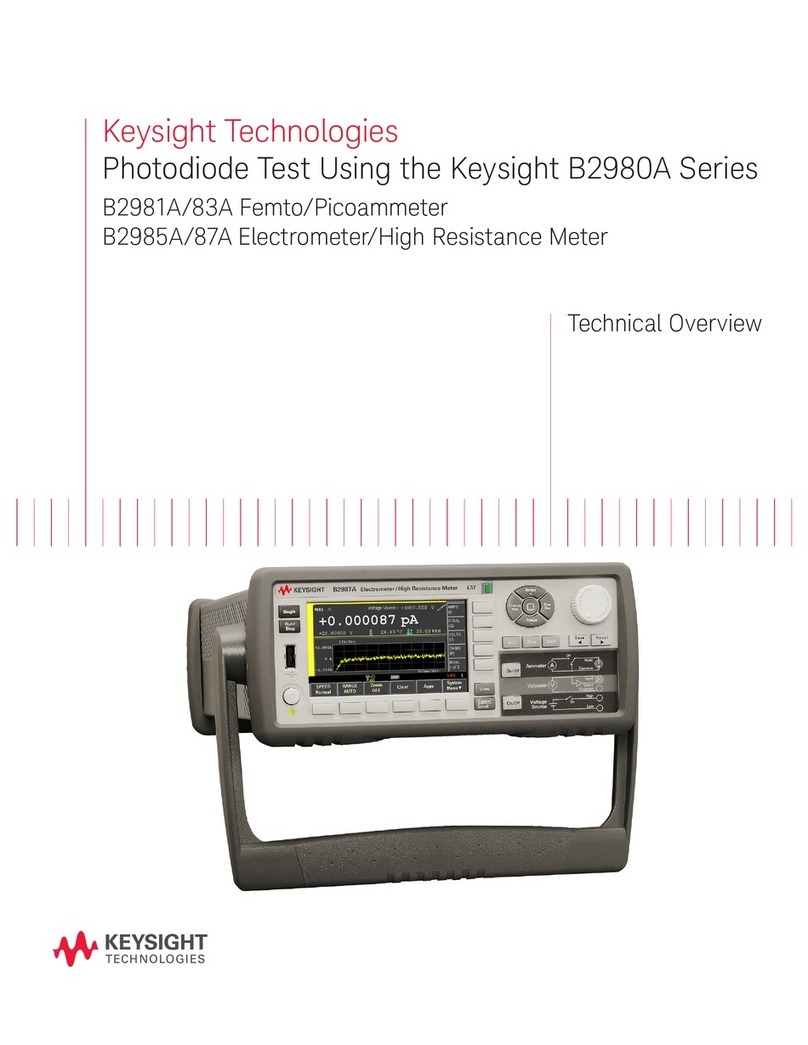
Keysight Technologies
Keysight Technologies B2980A Series Technical overview
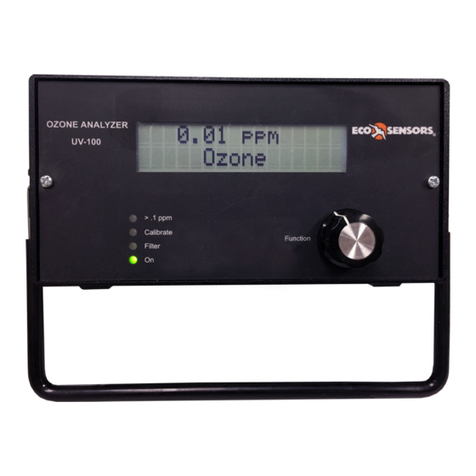
ECO Sensors
ECO Sensors UV-100 Instructions for use
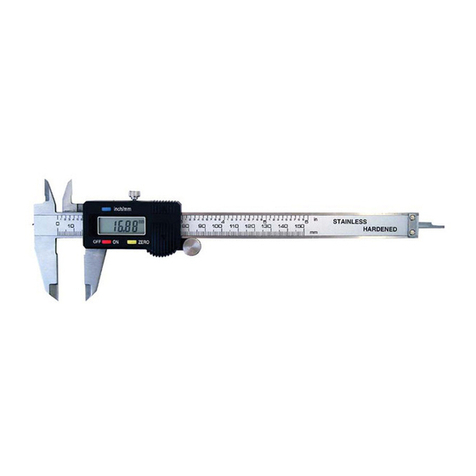
Powerfix Profi
Powerfix Profi Z22855 Operation and safety notes
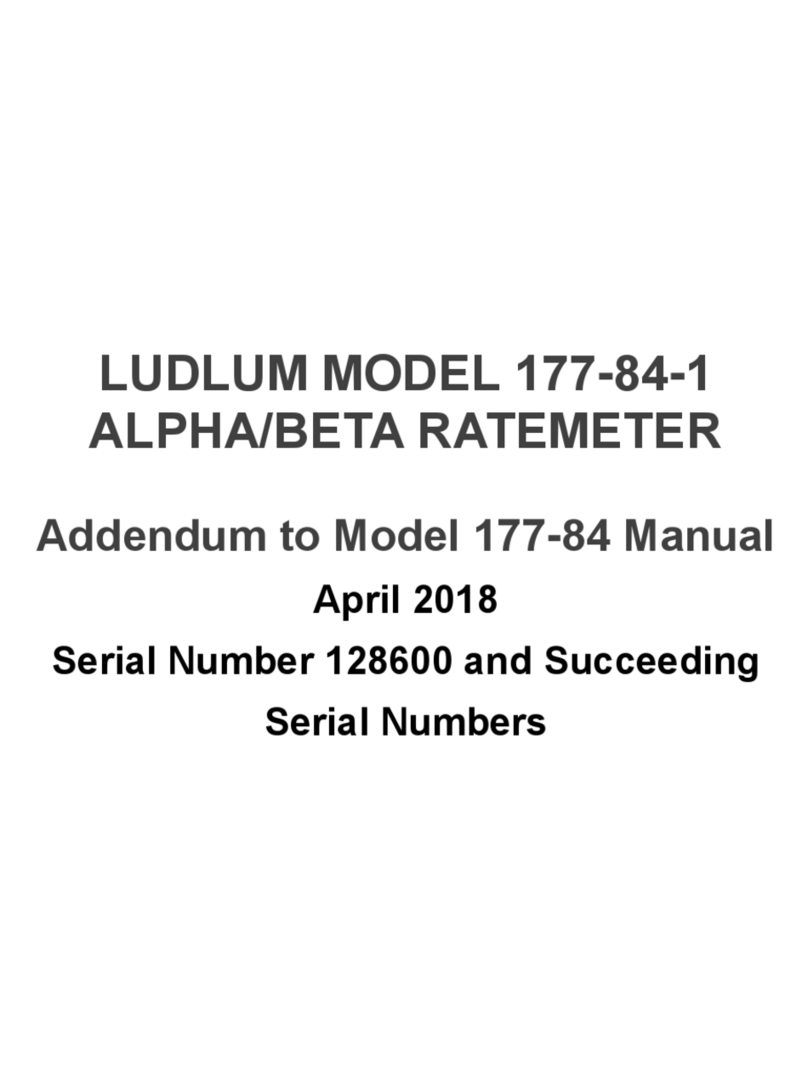
LUDLUM
LUDLUM 177-84-1 manual
Fluke
Fluke Datapaq Reflow Tracker user manual

turck
turck B N -QR20-IOL Series Instructions for use
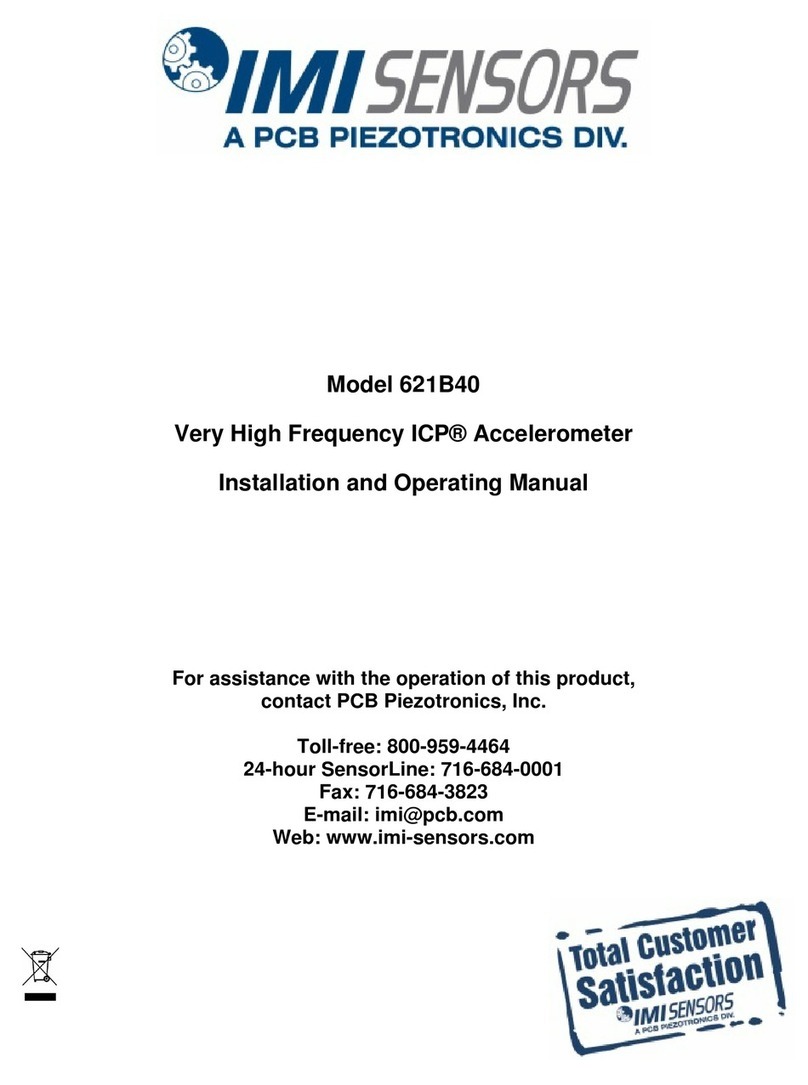
PCB Piezotronics
PCB Piezotronics IMI SENSORS ICP 621B40 Installation and operating manual
